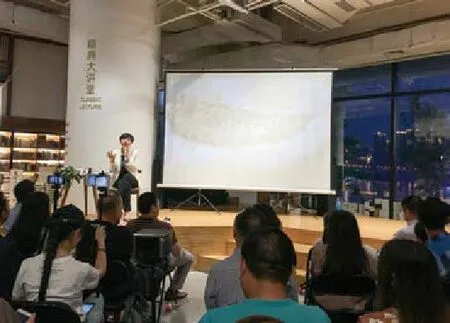《城门几丈高》讲述重庆开埠的历史
□ 文、图/本刊记者 熊怡
《城门几丈高》讲述重庆开埠的历史
□ 文、图/本刊记者 熊怡

6月1 6日,徐蓓在重庆精典书店和读者分享纪录片《城门几丈高》拍摄及幕后故事。
“在重庆逛街就像被一大群人挟着前行。涌动的行人呀,轿子呀,运货的骡呀、驴呀、马呀,还有无数的棒棒,肩上挑着根扁担,扁担两端用绳子系着两个大筐。凡是能在街上做的事,人们都在街上做。叫卖的小贩呀,修补瓷器的呀,这儿有理发师在剃头,那儿有穿戴整齐的女工匠……”
19世纪末,英国冒险家立德乐带着他的新婚妻子来到重庆,留下了这个城市早期的影像及文字记录。
2017年,由英国剑桥大学社会人类学硕士、英国政府志奋领奖学金获得者、国内资深纪录片制作人徐蓓导演,带着即将在央视播出的首部重庆开埠历史纪录片《城门几丈高》,为来过这里的外地人、外国人讲述,她的家乡重庆向西方国家打开城门,引领中国长江上游经济发展和对外开放,走过了一条什么样的路。
“城门城门几丈高?三十六丈高。骑白马,带把刀,城门底下走一遭。”
也许所有的重庆人都听过这首童谣。由于发音相近,这首童谣又有这样的版本:
“城门城门鸡蛋糕,三十绿豆糕。骑马马,坐轿轿,走进城门砍一刀。”
这部讲述重庆城市基因形成的纪录片片名,灵感来自于童谣《城门几丈高》。而这首童谣的产生与流传,本身就是故事的一部分。
深挖重庆的开埠历史,然而并不局限于本土。不久前公布的《城门几丈高》纪录片片段,透露出导演徐蓓看待历史的国际视野,以及她观察和认识事物新的方法论。“站在更广阔的时间、空间背景下,才更能发现重庆这座城市在历史上的重要性。”同时,徐蓓还分享了摄制组远赴英国寻找拍摄线索的独家花絮。
《城门几丈高》纪录片取材于1891—1945年这个时期的断代史,共分为5集。第一集《朝天门》,叙述清朝末期重庆的开埠历程;第二集《城门开》,介绍首批来到重庆的英国人对这座城市近代化进程的影响;第三集《潮水来》,讲述第一代民族资本家留学归来如何加快这座城市建设;第四集《舵把子》,展现民族资本家卢作孚在北碚进行乡村建设对重庆近代化的推进;最后一集《龙门阵》,呈现了抗战时期各路人士汇聚重庆的景象,就像在重庆摆了8年的“龙门阵”。抗战胜利后,有的人走了,有的人留下了,而这座城市的故事还在继续……
“在这部纪录片里,英国作为当时的西方之首,几乎占据了头两集的每一帧。”徐蓓说,重庆开埠,从第一批英国人进驻重庆,重庆现代航运业和城市近代化历程由此开始,重庆也成为中国西南地区最早向世界开放的地区。
立德乐,英国曼彻斯特人,第一个驾驶轮船通过三峡的英国人。《大不列颠名人录》至今仍称赞立德乐是“开发中国西部的第一人”,《重庆历史名人录》把立德乐列为在渝留下业绩的12位外国友人之一。当年,立德乐在重庆开设洋行,经营四川土特产和外国舶来品,这是重庆历史上的第一家外商洋行。立德乐用自己的冒险精神,和至今仍屹立在重庆南滨路的立德乐洋行旧址,在重庆近代史上留下了自己的印记。
1889年2月15日,立德乐驾驶蒸汽轮船“利川号”从宜昌出发,穿越三峡,经过二十多天航行,于3月9日抵达重庆朝天门码头,政府官员带领船只列队江中,鸣锣放炮迎候,上万名老百姓拥到江边观看。徐蓓介绍,像“利川号”这样早期在川江上航行的蒸汽动力船,当年都是在英国城市格拉斯哥的克莱德河畔设计建造和装配的。
遍布克莱德河两岸的造船厂,使格拉斯哥成为了曾经的造船中心。为寻找历史线索,徐蓓带领摄制组远赴英国设计之都格拉斯哥,探访了这座百年造船之都。在造船厂的陈列馆里,看到了曾经航行在川江上轮船的“古董”发动机。
从英国到中国重庆,立德乐及他的同胞—长江三峡商业汽轮先驱“肇通号”船长蒲兰田,用生命和时间丈量了两国的距离,也加快了重庆城市近代化的进程。
随着1891年3月重庆开埠,各国在重庆纷纷设立领事馆,并开设洋行、公司,建立工厂。英国人郝博逊在朝天门糖帮公所建立海关,后迁至太平门顺城街。
从1891年起,重庆海关每年都会留下关于这座城市的详细记录。重庆地方史研究会会长周勇说:“海关报告几乎就是一部‘百科全书’,比如,政府发生了什么事,今年建了几所学校,鸦片是怎么运进来的,甚至包括当时的女人解放裹脚,里面都记录得非常清楚。”可以说,重庆就是19世纪西方国家打开中国西部的一把钥匙。
“从历史发展角度来讲,重庆开埠实质是以英国为首的西方势力打开了中国西部的大门。”周勇认为,但从近现代化发展的角度来说,重庆开埠使这座城市成为长江上游地区第一个进入现代化的城市,与当今重庆引领长江上游经济有密不可分的关系,从纪录片《城门几丈高》可以一窥究竟。
“when going shopping in Chongqing, the street is so crowded that you tend to step forward under the arms of hordes of people. The street is crowded with pedestrians, sedans, goods-carried mules, donkeys and horses, and the Bang-Bang army who shoulder a carrying pole tied with two big baskets on its both ends. People in Chongqing are inclined to do anything allowed in street where it, thus, is fi lled with hucksters, porcelain menders, barbers who are serving their clients and well-dressed craftswomen.”
In the late 19th century, Leadery, an adventurer from Britain, came to Chongqing with his newlywed wife, then leaving the early image and written records of Chongqing.
The director Ms. Xu Pei, a China’s senior documentary producer, who has obtained master’s degree of social anthropology granted by Cambridge University and won the Chevening Scholarship, made the first historic documentary of recording the opening of Chongqing’s port—The City Gate with Several Meters High, which is going to be shown on CCTV in 2017. This documentary will introduce what a road Chongqing walked in its long journey of opening up to the western world as well as how Chongqing led an economic development and opening-up progress in the upstream of the Yangtze River to people from the rest of China and foreign friends.
“How high is the city gate? Thirty-six Zhang (120 meters). Riding a white horse and taking a knife, let’s take a walk under the gate.”
People in Chongqing may all have heard this nursery rhyme. As for the similar pronunciation, this nursery rhyme has the other version:“Egg cake in the gate, and green bean cake costs thirty yuan. Riding a horse and sitting in the sedan, let’s walk into gate and wave a knife.”
The name of this documentary recording how Chongqing took its shape was inspired by The City Gate with Several Meters High. However, they are also the part of story that how this nursery rhyme came to being and how it was spread.
When having an in-depth understanding of port-opening history, you’ll find that it is not limited within its indigenous part. The documentary segment broadcast not long ago unveiled the director’s international view toward history and her new ways to observe and know the world. “Standing under the broader background of both time and space, you will fi nd the important role of Chongqing played in its history.” At the same time, Ms. Xu also shared exclusive tidbits made in the journey of seeking shooting clues in the London.
Based on the dynastic history from 1891 to 1945, this documentary is divided into five episodes. The first episode called Chaotianmen records how Chongqing opened ports in the late Qing Dynasty; the second one called the City Gate is Open introduces the impact from the first British people who came to Chongqing on its modernization; the third one called Tidewater is Coming tells how the first-generation national capitalists who returned hometown after studying abroad made their efforts to speed up the development of Chongqing; the fourth one called Rudder Handle demonstrates how rural construction conducted by national capitalist Lu Zuofu in Beibei boosted the modernization of Chongqing; the last one called Longmen Battle Array shows such a grand image that people from different walks gathered in Chongqing during the War Resistance against Japan as if Chongqing has displayed “the longmen battle array” for eight years. After the victory of the War of Resistance against Japan, some people were gone, and some were left there while the story about Chongqing is still continuing…
“In this documentary, Britain as the lead of the western world almost occupies the first two episodes.” Ms. Xu said that since Chongqing started to open ports and the first British people settled down in Chongqing, its modern shipping industry and modernization began its new journey, thus Chongqing becoming the earliest region open to the rest of world in the southwest China.Leadery from Manchester, Britain, was the fi rst British person that succeeded in driving the ship through the Three Gorges. The Britannica—Who’s Who in the World still praises him as “the first person of developing the west China” and Historical Records of Chongqing listed Leadery as one of twelve foreigners who have made great achievements in Chongqing. At that time, he opened a foreign firm in Chongqing which mainly managed local products in Sichuan and foreign products, representing the first foreign firm in the history of Chongqing. Leadery, embracing the spirit of adventure, left his marks in the modern history of Chongqing as his foreign firm and warehouse still stand in the Nanbin Road of Chongqing.

On February 15, 1889, Leadery started his journey with the steamboat of “Lichuan” from Yichang, traveled through the Three Gorges, and then reached the Chaotianmen dock on the March 9th after 20-day navigation. Officials led boats to line up in the river while showing their welcome with fabulous decorations, gong beating and cracker fi ring, attracting thousands of people to have a look on the riverside. Ms. Xu introduced that at that time, steam-powered ships like the boat of “Lichuan” which traveled in the rivers of Sichuan in the early period were designed, manufactured and equipped in the Clyde Bank, Glasgow, Britain.
Bene fi ted by shipyards spreading all over both sides of the Clyde River, Glasgow became once a shipbuilding center. With the purpose of fi nding historic clues, Ms. Xu led her production group to Glasgow, City of Design in Britain, to visit this century-old shipbuilding capital. They also have seen the “antique” engine which sailed in the Chuanjiang River in the exhibition hall of shipyard.
From Britain to Chongqing, Leadery and his fellow, Pu Lantian, the captain of “Zhaotong”, a Chinese ship which entered Sichuan for its fi rst time, measured the distance between two countries with their life and time and sped up the modernization of Chongqing.
With the port-opening of Chongqing in March, 1891, many countries had set up consulates and opened the
fi rms, companies and factories in this place. Hobson, an Englishman, established customs in Tangbang Administrative Office, Chaotianmen Port which was then removed to Shuncheng Street, Taipingmen Port. Chongqing Customs has left a detailed record of this city every year since 1891. Zhou Yong, Director of Chongqing Local History Seminar, introduced that “the customs report is almost an ‘encyclopedia’”. It even clearly recorded what happened to the government, how many schools have been built this year, how did the opium come in and even the liberation of footbinding for women. It could be said that Chongqing was the key for western countries to open up the west China in the 19th Century.
Zhou Yong considered, “From the perspective of historical development, the port-opening in Chongqing represents essentially that the western forces led by Britain opened the door to the west China”. But from the view of modern development, the port-opening in Chongqing enables this city to become the fi rst modern city in the upper reaches of the Yangtze River. It has a close relationship with Chongqing’s current economic leadership in the upper reaches of the Yangtze River.
The City Gate with Several Meters High Tells the History about the Port-opening in Chongqing
Article, Picture/ Journalist Xiong Yi

